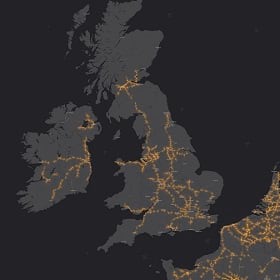If a fool knows the price of everything and the value of nothing, the saying goes double when it comes to data. Any CIO footing the bill for enterprise technology is keenly aware of how much it costs, but do they know the value of the data on which those systems run? Generally, no. For truly data-centric organizations, this may soon become an essential practice.
Though just 16 percent of business assets are tangible nowadays, few firms have been able to successfully value the data that represents one of their greatest intangible assets. The traditional business balance sheet is partly to blame. There, physical assets like buildings and vehicle fleets are valued explicitly, while data assets tend to be valued implicitly. But that scheme gives short shrift to the primary asset of the digital age. If data assets are in disrepair, a company might not give them due attention because their value isn’t obvious, and doesn’t carry a clear balance sheet consequence like a failing HVAC unit or an underperforming store would.
To bring valuation practices in line with the times, some executives are trying to put a value on their data. A pioneer in this movement is a government-owned company in the UK, and its early work on establishing the monetary value of data should make business leaders take notice.
Talking to the Business about Data
Highways England is the UK’s governmental organization charged with operating, maintaining, and improving England’s 4,300 miles of motorways and major A roads, which carry over two thirds of all freight. Its mission is to connect the country and increase the safety and reliability of these major highways.
Leaders of the organization have cut a new trail by bringing together different groups to understand and assign a monetary value to data, and arrive at a common business language to justify data investments. Don’t be surprised if business leaders in the private sector end up following this lead.
Highways England has assessed over 60 datasets that create value for internal and external stakeholders, including any group that depends on road transit—logistics providers, retailers, manufacturers, major transport hubs, commuters, local authorities, and data consumers.
During the evaluation process, its analysts discovered that the geospatial data about its road network was a particularly high-value dataset, covering everything from real estate to bridges to work trucks to the places where weather events occurred and the actual roads in the network. But it took a bit of a maverick to set the organization on a path to measuring that data’s monetary value.
“What we wanted to do is make data a bit more visible to the organization and to our people, our suppliers—from a perspective that they understand, which tended to be finance,” says Davin Crowley-Sweet, the agency’s chief data officer.
Investments in Location Data Multiply Value
Crowley-Sweet joined the agency two years ago after a long stint in the railway sector, where he became interested in the concept of generating value from data by treating it as an asset. Once at Highways England, he decided to do an experiment to uncover the types of data stakeholders prioritized, as well as the financial value of that data.
By gaining a common understanding of data’s value, he reasoned, the organization could better structure its investments in protecting, maintaining, and building this critical asset.
During the first stage of the assessment, Highways England pegged the value of its physical road infrastructure at £115 billion, and the intangible value it delivered to the country at £200 billion, according to Crowley-Sweet. Then they faced an even more difficult question: what proportion of that intangible value was derived from data?
“If our accounting rules were written in a digital era, would we still see data as something that isn’t valued on our balance sheet? My view is no, you wouldn’t. Data would probably be front and center,” he says.
To establish the data’s value, Crowley-Sweet and his deputy Victoria Williams began by calling representatives from every stakeholder group—59 interviews in all. The team talked to local authorities, major transport hubs, and data consumers, and identified the datasets that most supported their activities.
The team supplemented its phone interviews with online surveys to ensure the process was statistically robust. Roughly 300 people weighed in during the nine-month process.
“We asked those stakeholders to rank the Highways England initiatives they valued the most—things like maintaining the road surface and providing traffic flow data,” says Williams, head of data and information governance. The results yielded a measurable preference for each initiative, which the team then used to gauge data dependency, identify enabling datasets, and calculate the economic value created for each stakeholder group.
The value of organizational data came out to just under £40 billion for the top six stakeholders, and approximately £60 billion for all groups combined. The value comes in the form of time saved via traffic notices and roadwork alerts, as well as safety improvements and even reductions in emissions and noise. Crowley-Sweet and the team weren’t sure how members of the organization would react, considering it was the first time anyone had heard a number assigned to the data. People were more accepting than he expected.
He and the team then posed a question to their colleagues: “Our governance structures are geared around managing physical assets, but did you know that our virtual assets are one-third of the value of our physical assets?” The inescapable conclusion: the organization was not paying enough attention to its data assets.

If you find a company that has really good quality data, that's just a mirror image for all of their processes, be it safety, performance, finance, operations. Companies that care about data, they tend to care about everything.
Comparing Physical Apples to Digital Apples
The insight that followed—embedded in these questions posed by the team—couldn’t help but capture the attention of senior leaders:
- Did you know our data is worth four times the value of the technology that houses the data?
- Are we investing in the right proportions to protect and grow that value?
- Or are we just in the business of buying new hardware and software?
One notable revelation: the data that was key to helping the organization reduce operating costs was not the same data that drove customer value. For instance, the organization had traditionally focused on data related to road infrastructure—such as how much it cost to build and maintain new roads. But the data most valuable to stakeholders was information related to traffic flow, traffic speed, and weather events.
“We’ve been able to have a much more customer-focused lens on what datasets we need to focus on and why, which has brought an external dimension to how we view things,” Crowley-Sweet says of the findings.
For example, a lot of road maintenance work is done overnight on the assumption that that’s when traffic is lightest. But in fact, the logistics sector is busy making deliveries at night so that shops have fresh goods in the morning. This insight allowed Highways England to adjust the timing of maintenance tasks.
“Doing this work has also got us to understand much more around what our stakeholders need from us rather than us thinking we’re creating the value,” Williams says.
Highways England plans to repeat its data-valuation exercise every six months or so. For Crowley-Sweet, the effort to assign financial value to data and raise its profile pays off by increasing not just the return on data assets, but in the safety and well-being of stakeholders.
“We want to be sure that when you work with us, you get home to your families and loved ones safely,” he says. “If we’re sending people out to dig holes, I want them to know where the buried cables are. I want them to know where the ditches are, where the tripping hazards are.”
Like much of the organization’s important data, that information is housed in a geographic information system (GIS) that serves it up on smart maps.

The beauty of spatial data is if you ever want to improve your data quality, run a program that puts in a GIS system.
Location Data: The Most Valuable Player
Through their work, Crowley-Sweet and Williams established that on average, a £1 investment in data by Highways England produces £2.7 in economic value for the logistics companies, commuters, transport hubs, and other groups that depend on its roads.
Based on that assessment, they found that of the organization’s 60 data types, geospatial data describing the location of the roads within the network was the most valuable, coming in at a value of £3.2 billion. This dataset is critical for effectively managing traffic, incidents, network capacity, safety, and the environment. Highways England manages it all in GIS.
The next most valuable dataset involved traffic flow, at around £2.3 billion. Road information (accident alerts and other information pushed out to consumers) came to about £2.2 billion. For each type of location data, its intrinsic value grows when stakeholders—commuters, freight drivers, and others—make better decisions and improve efficiency and safety because of it.
Geospatial Data Gold
The valuation exercise helped Highways England spot what many businesses are eager to find—opportunities to bring datasets together and multiply their value.
Whereas a siloed business organization might ask questions like, “Are we on budget?” and “Was the work done on time?” Highways England now aims for higher-level insight such as how much it costs to run the M25. In short, bringing data together enables decision-makers to answer questions about value instead of questions around cost.
“Location gives them a common reference point,” Crowley-Sweet says. “But it’s more than just being able to put things on a map—it’s the ability to link different parts of the organization together to create the type of value that we’re trying to create.”
In Highways England’s case, that means linking the world of assets with the world of finance. Any transaction—for instance, a road repair—incurs a certain cost at a certain location. “So you can start configuring your financial systems to contain elements of spatial data to act as a common denominator,” Crowley-Sweet says. Then, rather than focusing on the cost of discrete transactions in a financial system, the organization can determine the cost to operate a service from location A to location B.
By seeking those patterns across datasets and anchoring financial data to location, “we can start to show a return on our data investments just like you can show return on other investments,” Williams says.

Viewing data as an asset supports our path toward data maturity and enables data-driven investment decisions.
Changing the Language of Value
In addition to promoting data sharing, the project established a common language for discussing data and its value. “It was about being able to give people the right lexicon—standard terms the business would use to put together a business case for a new investment—so they could have a meaningful conversation and create shared [understanding] around what data means to them,” Crowley-Sweet explains.
Valuing data within Highways England has had the effect of sharpening management’s focus on the stakeholders that are its customers. “We discovered that quite often, what we think is beneficial to the customer is actually not necessarily of true benefit to the customer,” Williams says. Every such revelation has its origins in data, which helps establish and reinforce the data’s value.
Understanding what is happening on the roadways is of immense value to Highways England’s stakeholders, whether that means facilitating the delivery of food and perishable goods, or knowing which roads are open and what condition they’re in. That insight, Crowley-Sweet says, “can really mean some profound consequences to villages and communities being able to survive.”











